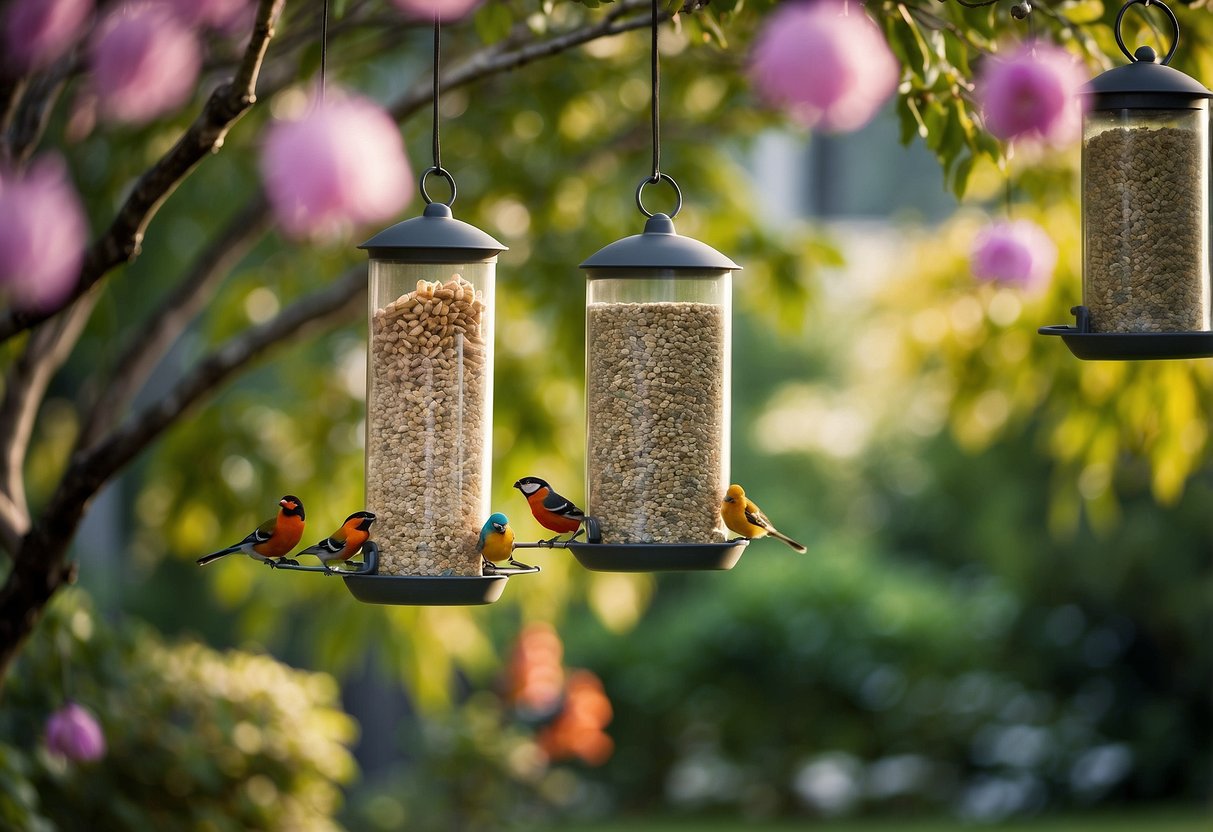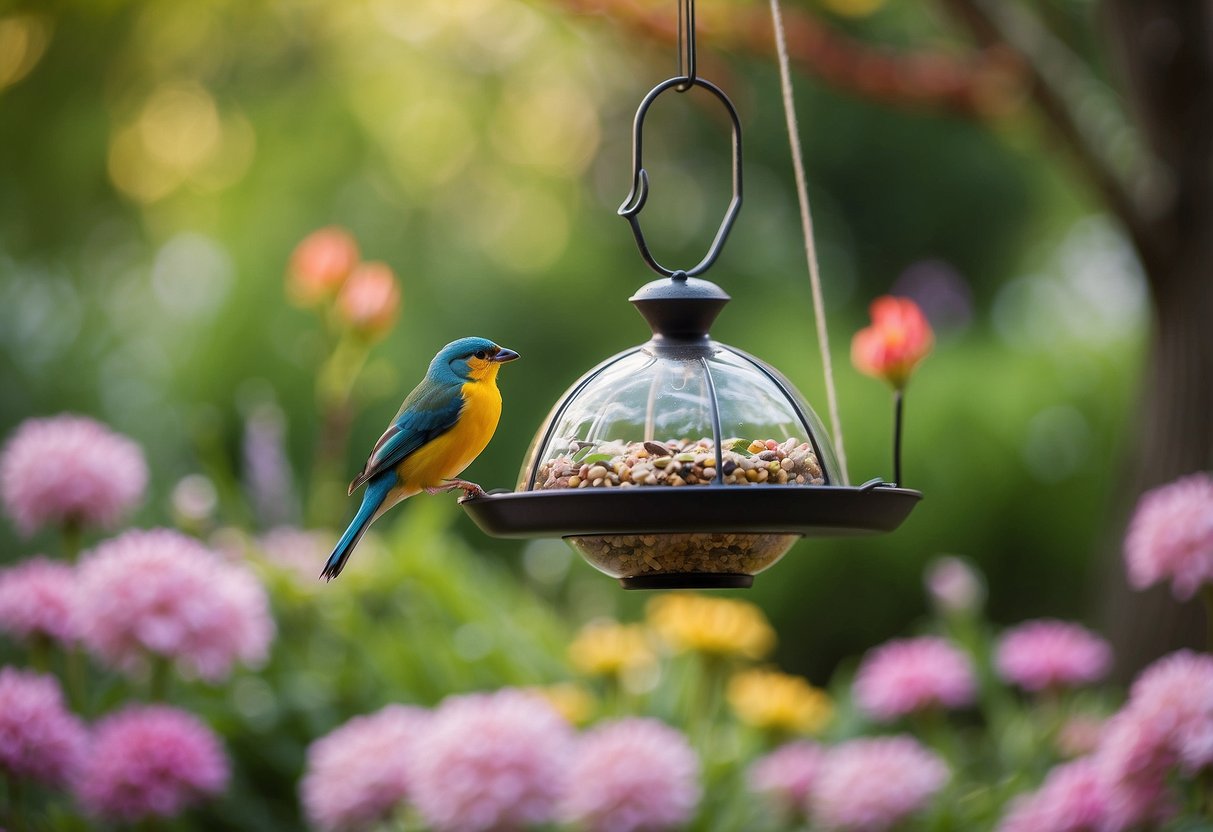Bird Feeder Garden Ideas: Create a Haven for Feathered Friends
Creating a bird feeder garden is a wonderful way to welcome and support local birdlife into your backyard. By choosing the right plants and landscaping elements, you can create a beautiful space that not only attracts birds but also adds charm to your garden.

A well-designed bird feeder garden can provide birds with food, shelter, and a safe place to rest. You’ll enjoy watching a variety of bird species as they visit, making your outdoor space a lively and vibrant sanctuary.
1) Hopper Bird Feeder

A hopper bird feeder is a great choice for attracting a variety of birds to your garden. These feeders usually have a large capacity and can hold different types of seeds.
The design typically features a roof to keep the seeds dry and a tray or perch for the birds. Some are made from recycled materials, like the Birds Choice Recycled 2-Sided Hopper Feeder.
Consider adding one to your garden to enjoy watching seed-loving birds.
2) Window Bird Feeder

A window bird feeder is a great way to watch birds up close. You can install it on your window and enjoy seeing birds come right to your home.
These feeders are easy to make and clean. You can also buy pre-made ones. They are perfect for small spaces like apartments or condos.
Making a window bird feeder can be a fun family project. It brings nature right to your window and provides endless entertainment. For some creative ideas and designs, check out these DIY window bird feeders.
3) Squirrel-Proof Bird Feeder

If you love watching birds but are tired of squirrels stealing the bird food, a squirrel-proof bird feeder is the solution.
Look for feeders with weight-activated perches that close off the seed openings when a squirrel tries to land. The Droll Yankees is a great brand to start with.
You can also try making your own using materials like glass and copper pipes. Check out some creative DIY bird feeder ideas for inspiration. Enjoy watching birds without the hassle of squirrels!
4) Tube Bird Feeder

A tube bird feeder is a fantastic choice for your garden. It’s simple, practical, and can hold a large amount of birdseed.
These feeders usually feature multiple perches, allowing several birds to feed at once. If you want a durable option, the Brome Mega 600 Metal Tube Feeder is highly recommended.
The design often includes a seed tube ventilation system, which helps keep the seeds fresh and attracts more birds. You’ll enjoy watching a variety of feathered friends visit your garden regularly.
5) Platform Bird Feeder

A platform bird feeder is a great project for your garden. It’s simple to build and attracts many types of birds.
To make one, use some wood scraps, a chain, and a metallic net. You can put it together in just a few minutes.
These feeders are budget-friendly and allow multiple birds to feed at the same time. You can attract cardinals, chickadees, and even woodpeckers.
For more tips, visit this guide on DIY Platform Bird Feeder Plans.
6) Dome Bird Feeder

A dome bird feeder is a great way to keep the bird food dry. The dome shape stops rain from soaking the seeds. It also adds a unique look to your garden.
You can find dome bird feeders made from clear plastic or metal. They often have tiny drain holes to let out any water that gets in. This keeps the bird food fresh longer.
If you’re worried about the weather, a dome bird feeder can be a real lifesaver. Plus, it makes it easier for you to spot the birds visiting your garden.
7) Nyjer Bird Feeder

Nyjer bird feeders are a great addition to your garden if you want to attract finches and other small birds. These feeders are designed for Nyjer seed, which is a favorite among goldfinches.
You can choose between tube feeders or sock feeders for Nyjer seed. Tube feeders have small feeding ports and perches, while sock feeders are mesh sacks that birds can cling to.
To reduce mess, look for feeders with seed-catching trays. This will prevent seed from falling on the ground and give birds another chance to eat.
Consider placing these feeders in a quiet spot to make birds feel safe while they feed.
8) Suet Bird Feeder

A suet bird feeder is a fantastic way to attract a variety of birds to your garden. Suet is great because it provides high-energy food for birds, especially in colder months.
You can easily make your own suet bird feeder. Use materials like wire and suet cakes to create a simple and effective feeder. Follow detailed instructions from Home Depot to craft one.
For those who prefer to buy, check out Bob Vila’s recommendations for the best suet bird feeders in 2024. These options are tested and reliable for any backyard.
9) Ground Bird Feeder

A ground bird feeder is perfect for attracting birds who prefer to feed at ground level. It’s a simple addition to your garden and can bring in various species you might not see with elevated feeders.
To start, choose a flat, open spot in your yard. This will allow birds to feel safe while they feed. You can use a mix of seeds to attract different kinds of birds.
Make sure the area is free from predators. Placing the feeder near some low-growing shrubs can provide quick cover for the birds. Adding mulch or paving stones around the feeder can help keep the area tidy and easy to clean.
10) Bird Feeder with Camera

A bird feeder with a camera brings your garden to life. You can watch birds up close without scaring them away. Smart bird feeders, like the Bird Buddy, offer high-definition videos and photos.
Some of these feeders come with features like night vision and real-time notifications. This means you won’t miss any bird activity, even at night.
Many bird feeder cameras are easy to set up and can be solar panel compatible. You can choose a model that fits your needs and enjoy birdwatching in a whole new way.
Choosing the Right Bird Feeders

When setting up your bird feeder garden, it’s important to know which feeders will attract the birds you want and what materials will last the longest in your outdoor space.
Types of Bird Feeders
Different birds prefer different types of feeders. A tube feeder is great for small birds like finches and chickadees. These feeders have multiple ports and can hold a lot of seed.
For ground-feeding birds like sparrows and doves, a tray feeder works best. This feeder is simple and flat, making it easy for birds to land and eat.
A nyjer feeder is perfect if you want to attract finches. These feeders have small openings to hold nyjer seeds, which finches love.
If you have hummingbirds, a nectar feeder will attract them. A common recipe for nectar is mixing four parts water to one part sugar. Make sure not to add red coloring, as it can harm birds.
Materials and Durability
When choosing bird feeders, consider the materials they are made from. Feeders built from sturdy materials like metal or high-quality plastic will last longer. Wooden feeders can be beautiful but may not hold up as well in harsh weather.
Metal feeders are often more durable and can withstand squirrels trying to get at the food. On the other hand, plastic feeders are lightweight and easy to clean but may crack over time.
Some DIY bird feeder projects use materials like plastic bottles or wood. These can be fun to make and eco-friendly options. Keep in mind that durability can vary, so check that they are sturdy enough to last through different weather conditions.
Placement and Design Tips

Choosing the right spot and design for your bird feeders can make a big difference. You’ll attract more birds and keep them safe and comfortable.
Optimal Locations
Place bird feeders near trees or shrubs. These spots give birds a place to hide from predators and rest. Choose areas with some morning sun and afternoon shade to keep birds comfortable throughout the day.
Keep feeders at least 5 feet above the ground. This height helps protect birds from cats and other ground predators. It’s also important to place feeders at least 5 feet away from windows to reduce the risk of bird collisions. Following these guidelines will help your feathered friends feel at home.
Creating a Bird-Friendly Environment
Use natural elements in your garden to attract more birds. Plant native flowers, shrubs, and trees that provide food and shelter. Adding a variety of plants will attract different bird species throughout the year.
Consider adding a water source like a birdbath or small fountain. Clean water is essential for birds, and moving water attracts them even more. Using mulch around the feeders can help keep the area clean by absorbing droppings and seed shells. Mulch is easy to replace, keeping your garden looking tidy.
Maintenance and Care

Taking care of your bird feeder garden involves regular cleaning and making seasonal adjustments. This ensures a healthy environment for the birds and maintains the garden’s appearance.
Cleaning Feeders
It’s important to clean your bird feeders regularly to prevent the spread of diseases among birds. Start by removing any old seeds and debris. Use a container with water and dish soap to scrub each part of the feeder. A brush works best for reaching small crevices. Once scrubbed, rinse thoroughly and let the feeders dry completely before refilling.
For a deeper clean, fill a container with nine parts water and one part bleach after you’ve scrubbed the feeder. This helps kill any remaining bacteria. Make sure to rinse thoroughly to avoid leaving any bleach residue. Cleaning your feeders every two weeks is a good practice, but adjust based on the number of birds and how dirty the feeders get.
Seasonal Adjustments
Adjusting your bird feeder garden with the changing seasons is critical. In summer, ensure feeders are placed in shaded areas to keep seeds fresh. During winter, you might need to add feeders or switch to ones that can withstand snow and ice.
Consider changing the type of feed during different seasons. Some seeds are better for winter feeding, while others are suited for summer. Larger shrubs and evergreen plants can provide necessary cover and food during colder months. In warmer months, focus on more flowering plants that attract insects, which are a natural food source for many birds. Regularly check and maintain bird baths, ensuring that they don’t freeze in winter or dry up in the heat.







